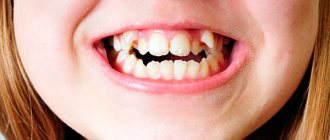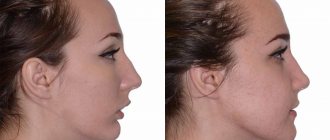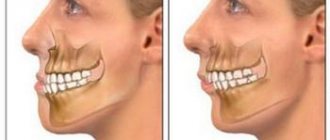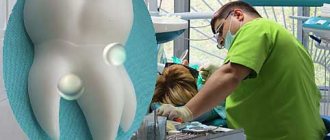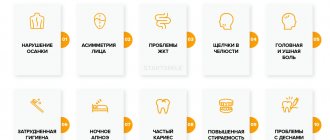Malocclusion is a common pathology that begins at an early age. Its symptoms are quite easy to notice, because tooth displacement is visible to the naked eye. Although children's malocclusion can be corrected at any age, neglected problems can greatly affect a person's life. It is necessary to establish as quickly as possible what disorder the child is suffering from and promptly correct it.
Typically, surgery is not required to correct most malocclusions early in life. At the same time, installing braces for a child is a rather controversial decision, because they can cause a lot of inconvenience, not counting individual contraindications such as metal intolerance. There are several alternatives that we will look at in this article.
Types of dental malocclusion in children
- Distal bite.
The lower jaw is posterior to the upper jaw
- Mesial bite.
Does the child have an incorrect bite, does the lower jaw protrude forward? This kind of bite is called mesial. In this poetic form, we can give a brief description of another common type of jaw disproportion, when the lower jaw is much more developed than the upper.
- Cross or scissor bite.
A less common, but very unpleasant dental anomaly. With a crossbite in a certain place, the jaws close in the opposite relationship - they close in reverse, which is why the dentition resembles scissors.
- Deep bite.
A very common type of malocclusion in children and adults, when the upper teeth cover the lower teeth by more than half.
- Open bite.
One of the most complex anomalies, causing physical and psychological discomfort to the child. The upper and lower rows of teeth cannot meet completely, causing a noticeable gap to form between them.
Above we described what a child’s malocclusion looks like in various manifestations, but we should also briefly talk about the correct one, which can be perceived as a kind of guideline. The ideal bite is considered orthognathic. It is distinguished by an absolutely even dentition without gaps, curvature or crowding, when the upper teeth cover the lower ones by one third. There are several types of correct bite, but if your child has dental defects, this almost always indicates problems.
What does a correct teeth bite look like?
Physiological (correct) occlusion in humans is characterized by:
- adequate form of dentition. The top one looks like a semi-ellipse, the bottom one resembles a parabola;
- the upper incisors overlap the lower ones by ⅓ of the height;
- there is contact between all teeth;
- the lower teeth are vertical, the upper teeth are inclined;
- each tooth, except 4, has 2 antagonists (one opposite);
- the correct bite in the diagram is marked by the symmetry of the incisors;
- chewing teeth are in contact with each other.
Correct bite in adults has its own variations. All of them are considered a variant of the norm:
- Orthognathic
. The upper teeth slightly overlap the lower teeth, and all molars and premolars occlude. - Straight
. The upper teeth do not overlap the lower ones, but join with them. The lateral teeth meet well. - Physiological progeny
. The lower teeth protrude beyond the upper teeth, but contact is maintained. The lateral teeth close together without gaps. - Biprognathic
. The incisors of both jaws are inclined forward, with intact contact.
How to determine malocclusion in a child?
“How can you tell if a child has a malocclusion?” - This is a question many parents ask. It is important to understand that only an experienced pediatric orthodontist can make an accurate diagnosis here, so we strongly advise you to undergo regular preventive examinations with this specialist from a very early age until the complete replacement of baby teeth with molars. If the baby teeth are located too closely together, this can also become an additional complication when the molars erupt (the latter take up more space because they are larger). In the case of a small child (under 3 years old), it is difficult to be guided by purely visual principles and determine by eye whether the bite is correct or incorrect. Be that as it may, there are a number of signs that directly or indirectly indicate that the child has prerequisites for orthodontic anomalies.
Improper breathing
The child's mouth is constantly in a half-open position, he does not breathe through his nose (of course, if there are no colds).
Snore
If your baby constantly snores in his sleep, this may also be one of the consequences of the development of malocclusion.
Jaw formation
Pay attention to how the child's jaws are formed. Ideally, there should be no noticeable disproportion between the top and bottom. Additionally, if a child continually pushes their lower jaw forward, this is considered a clear sign of pediatric bite problems.
Postural disorders
If your child has postural and spinal problems, this may affect the development of malocclusions.
Causes of malocclusion in children
The causes of malocclusion in children can vary, and most of them are difficult to address without orthodontic treatment. Below you can see a list of the key reasons for the occurrence of such anomalies in a child.
Genetics.
If you are wondering why your child has an incorrect bite, look at yourself first. Genetic predisposition is the most obvious and common cause of malocclusion in a child. If one or both parents have pronounced anomalies, then with a very high degree of probability their children will inherit them.
Bad habits.
Children often chew and put into their mouths literally everything they can get their hands on. Often such cravings provoke a violation of the formation and development of teeth. Malocclusion in a child from a pacifier is also quite common.
Breathing problems.
Children with nasal breathing disorders are much more likely to suffer from malocclusion, as experts say.
Problems with the musculoskeletal system.
The spine is the main “bearing structure” of our body, so it is not surprising that the functioning of the musculoskeletal system affects the dental system.
Other diseases.
The risk group (meaning malocclusion) also includes children with diabetes mellitus and central nervous system diseases.
Treatment of malocclusion in children
What to do if a child has an incorrect bite? Of course, start treatment immediately! Unlike adults, where malocclusions can only be corrected with braces or aligners (and in severe cases, surgery is often necessary), malocclusions in children are treated in a variety of ways. The technique depends on the age of the child and the specific clinical case. Below is a table showing possible treatment technologies for children of different age groups.
Malocclusion in a child under one year old
For very young children (up to 1 year), it is important to choose special orthodontic nipples for feeding, and also try to refuse pacifiers, which can negatively affect the development of teeth.
Malocclusion in a child aged 1–2 years
At this age, milk teeth begin to actively erupt, so the baby can already be taken to the orthodontist. When there is a potential malocclusion in a one-year-old child, special dental guards are often required to reduce the likelihood of developing malocclusions due to chewing habits.
Malocclusion in a child from 3 to 7 years old
By age 3, a child's primary teeth will usually have fully erupted, so correction of orthodontic problems can begin if necessary. At this age, to correct the bite, removable plates, trainers and LM activators are usually used, which are designed to straighten, expand or narrow the dentition, as well as improve diction.
Malocclusion in a child 8–9 years old
8 - 9 years are considered the borderline age when active replacement of primary teeth with molars occurs. It is important here that the process goes as smoothly and successfully as possible. To correct the dentition, the same trainers and plates can be used, as well as special orthodontic devices that ensure the correct interaction of the elements of the dental system, including muscles and soft tissues.
Malocclusion in a child 10–11 years old
At the age of 10, many children have a completely new set of teeth, so this age is considered the minimum acceptable age to start wearing braces. Today in orthodontics, aligners are also widely used - removable transparent aligners for correcting malocclusion.
Stages of bite formation
The first stage is completed by the time teeth erupt. Then it is formed:
- Temporary bite
Period: from 6 months to 3 years
. Teeth are actively growing, their relationship in the jaw is changing. When all the teeth have erupted, the stage of a formed temporary bite begins. It lasts until the moment when baby teeth begin to be replaced by permanent ones. The number of teeth is 20. Their location is influenced by the child’s habits: thumb sucking, sucking a corner of a bedspread, long-term use of a pacifier. Most causes of pathologies appear at this age.
- Replaceable (mixed)
Period: 6-14 years
. The active growth of permanent teeth increases the bite and promotes changes in the position of the jaw relative to each other. The jaws are in the process of formation. This is the ideal time for orthodontic treatment.
- Constant
Once all the baby teeth have fallen out, the bite becomes permanent. Number of teeth 28-32. With the appearance of fangs, the bite increases again.
The final formation of the jaws is completed by the age of 21, but the movement of teeth continues throughout life. The teeth are worn down by the friction of the side parts, because of this their position in the jaw changes, although we do not notice it. Dentists call this process mesial movement.
Consequences of malocclusion in a child
Unfortunately, it is still not uncommon for parents to have no idea what the dangers of malocclusion in children are and are rather irresponsible about their dental health. Over time, the child develops malocclusions that carry with him into adulthood. In childhood, teeth are much more mobile and respond well to directed mechanical influence, while correcting a bite in an adult is a much more complex and lengthy process. Moreover, adults are much less likely to agree to treatment because of the associated inconveniences and restrictions, which over time leads to a number of complications and unpleasant consequences. An incorrect bite leads to disruption of the muscles and joints of the entire dental system, which causes characteristic clicks, spasms and pains that spread to adjacent areas and lead to migraines, hearing loss and other unpleasant manifestations. Improper functioning of the temporomandibular joint, in turn, often leads to apnea (sleep breathing disorder), which is an additional factor in the occurrence of cardiovascular diseases and leads to much more tragic consequences.
Why is malocclusion dangerous in children from a psychological point of view? If a child has serious abnormalities, this will certainly affect his self-esteem (especially in adolescence and adulthood). In the modern world, a smile is perceived as an integral part of the image of a healthy and successful person, so the issue of aesthetics in this case is also very important. As you can see, everything in our body is interconnected, so do not put off orthodontic treatment under any circumstances, especially since in childhood any problem is corrected easier and faster.
Types of bite correction
Orthodontic and surgical types of bite correction depend on the nature of the pathology. In case of skeletal abnormalities, surgical intervention is necessary to correct the bite. In other cases, with dental anomalies, only orthodontic treatment is sufficient. In our clinic, we use aligners for this - invisible mouth guards that allow you to correct all types of dental bites in a person of any age. The technology allows you to achieve a guaranteed result within a predetermined period, and even before the start of treatment you will see what your smile will look like after the bite is corrected.
